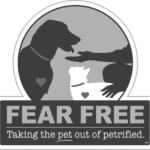My Least Favorite Things
October 9, 2014
 I am so fortunate to have a career (a calling really) that intrigues, inspires and challenges me. I absolutely love what I do. And I love that, on random days, miniature piglets may show up at my job (see piglet selfie, at left.) For me, most days as a veterinarian are good days, and I’ve written previously about some of my favorite things in veterinary medicine.. Of course, being a mere human, I do have bad days, too. Bad days for me usually involve one of the following things:
I am so fortunate to have a career (a calling really) that intrigues, inspires and challenges me. I absolutely love what I do. And I love that, on random days, miniature piglets may show up at my job (see piglet selfie, at left.) For me, most days as a veterinarian are good days, and I’ve written previously about some of my favorite things in veterinary medicine.. Of course, being a mere human, I do have bad days, too. Bad days for me usually involve one of the following things:
1.) Torn nails
Ouch! Veterinarians and technicians alike cringe when a dog limps in with a torn nail. A common injury in active dogs, avulsed nails result from vigorous running or digging outside, where the nail gets snagged on something. The nail can be partly or almost completely torn from the nail bed, resulting in pain, bleeding and sometimes infection, particularly if Fido is licking the offending toe. There is only one cringe-worthy treatment for an avulsed nail: either pulling out the nail entirely, or cutting it back to the nail bed, below the point where it is torn. Ouch. Double ouch! Most of us hate to perform this procedure, but it is very quick, and often results in immediate pain relief once the broken nail is removed. We bandage the foot until the open nail bed scabs over, and then Fido is good to go! Typically the nail grows back uneventfully. I’ve removed avulsed nails for a decade, and yet they still make me cringe every time. (I’d take a nasty, smelly abscess any day over one of these!)
2.) Retractable leashes
I’ve talked about it before (see my previous blog post) and will continue to talk about it until retractable leashes have been retired for good. Retractable leashes are a recipe for disaster. They do not allow dog owners appropriate control, they easily become knotted and non-functional, the clasps break preventing “locking” of the leash at a reasonable length, they become twisted and tangled when left too long…I could go on. Veterinarians, veterinary technicians and veterinary behaviorists uniformly agree: retractable leashes are one of our least favorite things.
3.) Morbidly obese pets
A simple truth: pet obesity is an epidemic, with greater than 50 percent of cats and dogs estimated to be obese.. Despite the frequency with which I diagnose obesity in my patients, discussing obesity with caring clients is never an easy task. I’m Italian, so I know more than anyone that food can equate to love in many households. Many dog and cat owners don’t even realize that their pet is overweight, until I bring it to their attention. Often, I hear things like “Well, Fluffy is really big for her breed” or “Our last Labrador was the same size and she wasn’t fat”. The reality is that most pet owners aren’t even aware of what a lean dog or cat should look like. So many of us are killing our pets with love (read: food). Obesity shortens Fido’s life span, increases his risk for cancer, arthritis, respiratory disease and a host of other problems. The good news is that this disease is entirely treatable, assuming an appropriate diet plan can be implemented and maintained!
4.) Running behind schedule
I would describe myself as “pathologically prompt”, often arriving for my own appointments and dinner plans ahead of schedule. In my personal life, I am rarely tardy (and tardiness, when it does occur, can usually be blamed on my less-than-fast moving six year old son!) When seeing appointments at work, I strive for the same promptness. There are some days, though, when promptness is next to impossible. Most clients call ahead to schedule appointment slots for their sick pets, but sometimes animals are rushed in to us on an urgent basis. A few sick patients or emergency appointments can cause delays for scheduled appointments. My experience is that most clients are incredibly understanding when we are running behind, because they realize that the same courtesies will be extended to their own pets if they ever fall ill. It still troubles me to run late, since I know that everyone’s time is valuable, and I also want to ensure that all of my patients and clients are receiving the “doctor time” that they deserve.
5.) Talking about money
The stark reality is that owning a pet, and caring for it appropriately, costs money. Annual examinations, vaccinations and other preventative care can cost hundreds of dollars a year, while a major hospitalization or surgery can run into the thousands. This is not an inconsequential amount of money for most of us, and your veterinary team is very sensitive to the financial concerns that our clients have when it comes to Fluffy and Fido’s care. Talking about the cost of veterinary care is never an easy topic for veterinarians, technicians and front-desk staff (who receive the bulk of complaints and concerns about the cost of Fido’s excellent care.) I know that financial constraints are real for many clients, and I try to work within everyone’s budget to provide the best veterinary care possible. It’s my job to offer Plan A (the “Cadillac”) for Fido’s treatment, but if Plan A isn’t within the budget, then we will find a Plan B and even a Plan C, if needed. We will always work with clients to ensure their pet receives the best care possible within any budgetary constraints.



